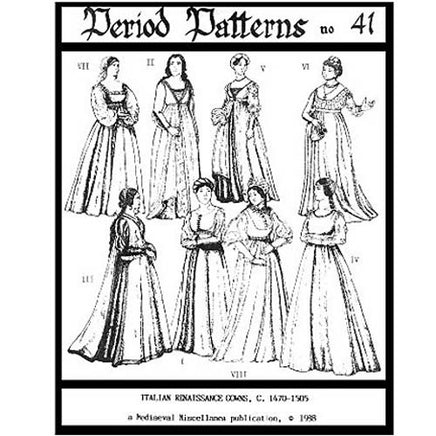
The Renaissance in Italy
Period Patterns number 41, Women's Italian Renaissance Gowns, c. 1470-1505, provides patterns for 7 gowns & 1 tabard (sizes 8-18). Two have split skirts. underskirts, and stomachers, to fake an underdress. The underskirts and stomachers can be left off, replaced by a real underdress. Four of the gown patterns have sleeves that tie on.
This pattern goes well with Period Patterns no. 90, 92 and 93.
The Renaissance of the 15th and 16th centuries began in politically splintered Italy. The age was humanistic, like the people themselves; the clothing was individualistic, competitive, even playful. While there were broad similarities, regional variations were the norm.
Women
Fashion for woman changed radically after 1460. Evolving from the houpelande (Period Patterns #26), the bodice was cut separately from the skirt, above the natural waist, and became tight fitting. Skirts could be gathered or pleated or neither. They were often split in front to show the skirt of a sleeveless underdress, which could also show under a V-neck. The chemise (Period Patterns no 90), decorated or not, also often showed at the neck. The sleeves could be slashed to show the chemise sleeve , and were often laced or tied to the bodice, rather than sewn on. This allowed different sets of sleeves to be worn with one gown. A sleeveless tabard was occasionally worn over the gown.
Zelikovitz Leathers is an Official Distributor of Mediaeval Miscellanea Period Patterns and stocks the full line of available patterns.
Mediaeval Miscellanea has created copyrighted Period Patterns for sewing authentic period clothing. The patterns, designed by professional costumers, are rigorously researched to ensure historical authenticity. Each package includes complete, full sized cutting patterns in all sizes listed on the envelope (which permits easier custom fitting; sizes are based on standard commercial pattern sizes and can easily be scaled up or down to create additional sizes). Detailed, fully illustrated, step-by-step sewing instructions are provided in addition to general instructions (seam finishes etc.), and most patterns include suggested pattern layout.
Each pattern package contains historical notes with illustrations from contemporary sources providing background information, as well as possible enhancements and variations. On the back of the package additional important information is provided including garment description (with country and approximate dates where possible), sizing, notions and yardage requirements for each size and suggested fabric type for each garment.
